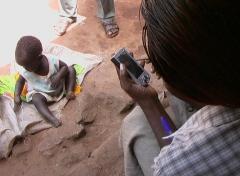Using mobile phones to track immunizations
The newsletter of Optimize this time features an article about openXdata and the project mVAC. Optimize is a collaboration between WHO and PATH which aims to create a flexible and robust vaccine supply.
Main content
Article by Jørn Ivar Klungsøyr on behalf of openXdata and Jan Grevendonk, PATH.
In August 2010, the Norwegian Research Council approved funding for a new project that will allow countries to manage immunization programs with increased accuracy and reliability by enabling health workers to record and register individual immunizations using mobile phones. The project, called Mobile Innovations in Recording Child Vaccination and Health Data in Immunization Registers (mVAC) builds on the work of its many partners and applies existing technologies in a fresh and innovative way that could radically improve the way vaccines are managed.
The goal of the three-year mVAC project is to develop an end-to-end mobile phone-based solution to create a fully digital system for recording immunizations at the individual level: one that can be implemented in almost any country with or without a public unique person identification structure or system.
The project uses an open-source software package called openXdata that allows users to create their own forms on a web-based interface and deploy that to mobile phones or devices. OpenXdata is being actively used in many different fields and will soon be implemented in Albania with Optimize and others. The software is constantly enhanced with input from users and developers on almost every continent. OpenXdata is a collaboration between many different institutions, companies, and individuals. As a result, openXdata software has the flexibility and simplicity to make it a good fit for different geographic environments and management systems.
How it works
Primary health care workers will be equipped with a low-cost, Java-enabled mobile phone with an integrated camera (approximately US$40) to record and submit vaccination data to a central vaccination registry. Child health cards with 2-dimensional bar codes will serve as the primary identifier for individual children. Using the camera on the phone, health workers will scan the card on each visit to see a list of immunization tasks scheduled for that particular child. When the immunization is given, the health worker documents it on the mobile phone and on the card and digitally signs the encounter.
Children who have migrated from other areas can be tracked by their card, and children who have lost their card can be looked up by name and other key identifiers, such as location, mother’s name, sibling names, etc., in the central register. The health worker can then issue a new card on the spot.
When the system is fully operational, the registry can generate lists of children in specific catchment areas who are overdue for vaccination and give it to the health worker prior to a session. Taking this a step further, the system can send automated SMS (short message service) text messages with reminders to parents that have signed up for this feature.
At the central level, the immunization registry allows the supply chain management system to deliver exactly the right amount and kind of vaccines to each individual facility based on monthly consumption data.
Why it is needed?
Too often, decision-making that affects the lives of a large portion of the population depends on unreliable and fragmented data. Most reporting and documentation efforts today are based on pen and paper-based systems of past centuries that are error prone and preclude rapid aggregation and analysis of data. In the context of immunization, distribution planning is often based on demographic data. Stock levels are maintained to allow for immunization of 100 percent of the theoretical population plus a buffer stock. Since there is, at best, limited up-to-date knowledge of consumption data at lower levels, managers maintain high levels of buffer stock to compensate for a lack of data. With the introduction of pricier and bulkier vaccines, this is quickly becoming increasingly unfeasible and uneconomical.
A centralized immunization register addresses these problems and transforms supply chains from inefficient supply-driven systems to accurate and reliable demand-driven systems.
To learn more about the mVAC project, visit www.openxdata.org
Questions about the project can be directed to contact@openxdata.org
